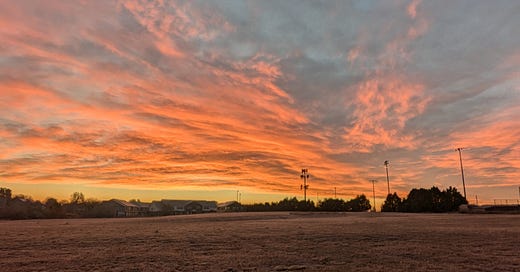Awareness, Grief, and Hope: On Loving a Changing Planet
“In this trembling moment . . . is it still possible to face the gathering darkness and say to the physical Earth, and to all its creatures, including ourselves, fiercely and without embarrassment, I love you, and to embrace fearlessly the burning world?” - Barry Lopez
I read these words from Barry Lopez’s essay “Love in a Time of Terror” six weeks ago as Hurricane Milton was passing over Florida, just days after Hurricane Helene brought unexpected devastation to other parts of the country. Most of what I write about here pertains to the beautiful and awe-inspiring, transcendent side of nature. But I would be negligent if I didn’t bear witness to the terrifying and heartbreaking sides of our relationship with nature, as well. When Barry Lopez referred to “The gathering darkness” in the quote above, he meant all the ways human beings are harming and altering the planet: war, unchecked development, runaway carbon emissions, elimination of species, etc.
Our family encountered some signs of this gathering darkness in our travels over the summer. On the day we visited the Monterey Bay Aquarium, for example, I learned as much about plastic pollution in the ocean as I did about sea creatures. Displays describing the problem were included in nearly every exhibit. The interactive children’s area even had a video game designed to teach about the dangers of plastic waste to sea life. Players controlled fish who swam through the ocean eating what floated around them. Sometimes players got lucky and ate plankton or smaller fish. Sometimes (as in this photo) they ate plastic bottles and straws.
In Alaska, we visited glaciers that had receded dramatically in the past century. The photos below show the Holgate Glacier in Kenai Fjords National Park. I took the larger photo on our boat tour this past July. The two captioned photos are from the National Park’s Visitor Center, displaying how much the Holgate glacier has shrunk over the past century. In the 1909 photo, two arms of the glacier reach down to the water of Aialik Bay’s Holgate Arm. In the 2016 photo, only one arm of the glacier reaches the water, but it’s not visible because of the angle at which the photo was taken. My photo from the boat in July faces the portion that remains in contact with the water.
I’ve seen similar before and after photos of other glaciers we visited this summer: Exit Glacier in Kenai Fjords, Grinnell Glacier in Montana, Blue Glacier in Washington. When I took a group of out-of-state visitors to see Colorado’s Arapaho Glacier in September - the largest glacier in the state - one found it hard to hide her disappointment at how small it was.
None of this is news. But seeing it firsthand forces one to ask the question: How then should we live? The aquarium made it easy, at first, to repent of our habitual use of single-use plastic. The cafeteria served our lunch on reusable plates with real silverware, with no plastic straws in sight. We hadn’t traveled far beyond the aquarium, though, before we caught ourselves purchasing and using plastic again. We read the signs, got the message, and promptly returned to our ordinary ways of living.
At one point in her book Looking Up: A Birder’s Guide to Hope Through Grief, Courtney Ellis describes a road-trip with an environmentally conscious friend who couldn’t stomach the thought of supporting the oil companies whose gas stations provided the only fuel available on the trip. To continue the road trip, idealism had to give way to compromise, and that led to tears. Eventually, grief can motivate action, and all action is an expression of hope, so Ellis offers grace suggesting that all of these responses have their place: “We are invited to a dance from awareness to grief to working for good to trusting God with the rest” (Looking Up pp. 98-99).
I’m trying now to turn from awareness and grief back toward working for good and trusting God. Last week I attended a continuing education event for professional coaches about “Eco-Coaching” - coaching individuals in ways that help them recognize the environmental impacts of their decisions and empowers them to act with hope. I learned about visualization exercises that to lead to help people envision the future of their descendants and change the way the live now to become better ancestors. Later this morning, two other spiritual directors and I will meet to discuss Brian McLaren’s book Life After Doom: Wisdom and Courage for a World Falling Apart. It seems we all need new tools to live and serve in a world where “ecoanxiety” and “climate despair” are increasingly common mental health concerns.
These are small ways that I’m trying to care for others and help them love the world. My calling is not to be a scientist, or politician, or activist. I feel increasingly drawn toward the one-on-one side of ministry, caring for individuals and accompanying them as they discern and grow. Writing provides a different kind of one-on-one connection, available on a larger scale but still personal. So I continue to pray that my writing will inspire deeper reverence creation, and that such reverence will motivate change within us to be better stewards of the earth. These are all small actions, but I offer them in love and trust God to use them for good.
The sun rose as I was about two miles in to my morning run today. I was facing and moving west when I noticed everything around me starting to glow orange and yellow. I turned around to see the clouds lit up as though they were on fire, a reminder that each new day is an opportunity to love a burning world and chose hope in the face of darkness.








